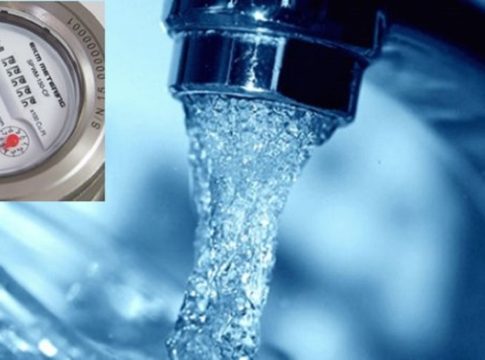Management of the Ghana Water Company Ltd has introduced an electronic billing system to tackle challenges such as delays in billing, non-billing, non-reflection of bill payments, and difficulty in monitoring meter readers among others.
The utility company says the new system will significantly reduce the time between customer meter reading and customer billing, eliminate arm-chair meter reading, effectively reduce human errors inherent in the current billing system, link customer billing to customer location, allow for bill payment anywhere in the world, enable online service connection application and reduce new service connection time.
“This introduction seeks to use the power of mobile telephony, especially, as the mobile phone penetration in Ghana, according to the NCA, is over 115%,’ said a statement issued by GWCL Regional Communications Manager Western & Central Regions, Nana Yaw Barima Barnie.
hana Water Company Limited (GWCL) is mandated by law to supply potable water to urban Ghana. The company currently has 617,362 customers across 13 administrative regions in Ghana.
These customers are currently billed every month through a manual process where meter readings are manually entered into the billing system. This billing system is replete with a number of challenges which include delays in billing (minimum of 28 days), non-billing, non-reflection of bill payments; difficulty in monitoring meter readers etc. These challenges render the current billing system ineffective, increases non-revenue water and does not give a true and accurate picture of consumption levels and patterns among consumers.
In addition, GWCL spends at least two million Ghana cedis on bill printing, buying and servicing of computers and printers for billing among other operational costs. In this modern era where utilities leverage the power of technology and innovation to improve their services, it does not make economic sense to continue on this downward trajectory.
Concept and Approach
The transition to e-bills hinges on; Software as a service, cloud-based billing system (SMS and emails), Meter reading and Monitoring applications, Call Centre Management, Customer/User application and Point of Sale Application.
The first step towards transitioning to e-bills was validation of customer details such as GPS location, Meter Number, Account Number, Phone Number and email, if available.
A validated customer is one whose meter’s GPS Location and at least one phone number have been captured on the GWCL e-billing platform. Having validated the customers, meter reading is done with android devices which have a GWCL meter reading mobile application pre-installed. At the customer premises, the meter reader enters twice the cumulative consumption recorded by the meter and takes a picture of same. This two-step process effected by the meter reader completes the whole billing process. The rest of the process is done at the background. At that instant, the customer’s bill for the month is sent to him/her via text or email or both.
With this modern system, bill delivery will no longer be a minimum of 28 days but almost instantly. It is important to explain that the meter reader is constrained by location such that if he is not in the customer’s premises or beside the meter, he will not be able to read the customer’s meter for the bill to be sent to him/her.
Implementation
The e-billing project was launched in Tema region on May 24, 2016 after which the necessary preparatory work began. On August 1, 2016, customer validation started in Tema on a pilot basis. Following a successful pilot, the project was rolled out in six more administrative regions constituting phase 1 of the project. Thus, under phase 1 of the project, the following regions began customer validation and subsequent e-reading of customer meters:Tema, Accra East, Accra West, Western, Central, Ashanti North and Ashanti South.
By the end of May 2017, 80% of the total customers in the afore-mentioned regions had been validated. However, in February 2017 when most of the seven regions had validated at least 70% of their total customers, e-reading of meters commenced. From February 2017 to date, GWCL has undertaken e-billing of customers alongside the existing manual billing process. This means the meter readers read meters with the android devices given to them and also record the figures manually in their meter reading books. Thus validated customers have, since February 2017, been receiving the traditional paper bills as well as e-bills via phones as SMS and or emails.
According to the implementation plan, manual reading of customer meters shall be gradually phased out so that only the android devices will be used for meter reading and customer validation.
Convenience of Paying Water Bills
The billing process is said to have been completed only when customer payments appropriately reflect in their records. Major improvements have been made in the process of bill payment. Customers now havethe convenience of making payments via a plethora of flexible payment options such as existing GWCL payment points, Authorized Private Collectors, Partnered Banks, Mobile Money (MTN, Tigo, Vodafone & Airtel), Slydepay, Expresspay, etc. Payments through Visa, Mastercard, and GWCL customer application is also available at Google Playstore and Apple Store.
Appeal
Customers who have already begun receiving their e-bills are happy with the improved system. It must be emphasized that the success of the transition, to a very large extent, depends on the cooperation of GWCL customers who are required to make suggestions to further improve the system. Customers are entreated to permit our clearly identifiable officers to validate their subscriptions, read their customer meters promptly and also provide us their phone numbers.
One major challenge with the old billing procedures is that, it took at least 28 days for payments to reflect on customer bills. In cases where payments were made outside a customer’s region, it took even longer.
This was due to the way customer database was managed. Each region had its own database which was not linked to those of others.


